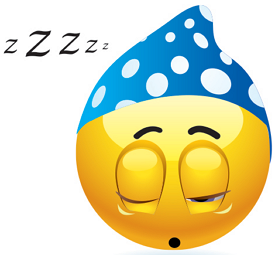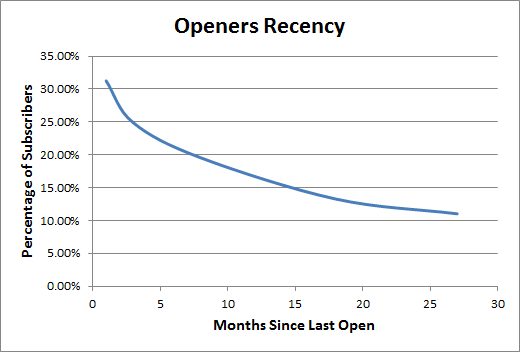 Are you throwing away 10% of your revenue by doing what you’ve been told is the right thing with inactive subscribers?
Are you throwing away 10% of your revenue by doing what you’ve been told is the right thing with inactive subscribers?
That’s entirely possible if you follow widely held best practice. You know, those subscribers that haven’t opened any of your emails for over 3 months, you might as well stop emailing them?
After all, if you send say two emails a week, then after three months you’ve been ignored almost 30 times. You’re clearly not welcome?
The evidence is to the opposite, some of those subscribers who go through periods of not being interested in your offers can and do come back. In fact I commonly see over 10% of revenue comes from people who would have been considered inactive.
The chart below shows the response curve for the percentage of subscribers who opened by the date of last open. There are two key takeaways from the chart:
- It takes almost two years, before the chance of getting an open again, drops to nearly zero. You have to keep sending for at least two years to inactives before giving up.
- The longer the time since someone last opened the lower the chances of them opening again. Target contacts who haven’t opened for 6 to 12 months to get re-engagement.

The chart is based on real data and is typical of the response curve for the percentage of subscribers who opened by the date of last open.
The shape of the curve is very consistent across different brands. What varies is the steepness and speed of drop over time. This is impacted by type of email content and emailing frequency.
Why are Inactive Subscribers still Valuable?
The truth is that inactives are made up of 3 different types of contact; Low engagement customers, zombies, spam traps.
- Low engagement customers. These are the contacts that can still deliver revenue. Valid emails addresses to potential customers, who scan your subject lines from time to time. The issue isn’t that they don’t want you. Just they don’t want you now and may be not for some months to come.
- These are valid email addresses but the inbox is never looked at by the owner.
- Spam Traps. These are poison for deliverability. They are not personal email accounts but inboxes maintained by ISPs to spot spamming activity.
The percentages you have of each in your inactive segment is determined by your data capture and data management practices.
Low Engagement Customers
As well as contacts that have simply not opened for a long time, it includes email addresses that have yet to open a first email.
Whilst welcome emails have high open rates, it can take many more emails before everyone who is going to open finally does open an email. They should be treated in the same way, just keep trying until the chance of getting a response drops to near zero.
Zombies
Very often they are secondary email addresses kept by their owners for the purpose of giving out to brands when an email address is required.
Though it also includes email addresses once used by the owner and long since abandoned. The difficulty is when users abandon an email address they never officially go through the process of closing the mail account.
The number of Zombies is highly influenced by how and why an email address is being captured. Whether it is a newsletter signup form or a barrier page to what the user really wants to get to. Purchased data is also particularly risky.
Minimize zombies by giving strong reasons and incentives for a valid primary email address to be provided and having a clear policy of not sharing email addresses.
Spam Traps
List hygiene and data management are important to avoid building up spam traps. In particular not re-introducing old newly re-discovered data and ensuring that bounced addresses are being correctly purged.
Finally as with zombies, purchased data is particularly risky.
Inactives Open with Intent
Whilst open rates are low for inactives compared to actives, the click to open rates are much higher, double or quadruple.
When low engagement customers finally do open they do so with far more intent to act than active customers.
Better Engagement Tracking
Whilst I’ve focused on recency of open to determine low engagement subscribers, in reality both open and clicks should be used.
A small number of subscribers click without an open being tracked. So it’s better to base everything on last email response, being an open or a click.
An even better model is to incorporate website visits as well as opens and clicks. Emails nudge people to visit your website, possibly even on a different device.
Using website tracking back to subscribers allows treatment of email inactive subscribers that are engaged on your website differently to those that are not.
When to Remove Inactive Subscribers
Ideally low engagement customers would always be kept, with zombies and spam traps removed.
However, it’s not possible to easily distinguish between these different types of contact. Since their behaviours are so similar.
So the default position is to just keep emailing all inactives unless there is a very good reason not to.
The two main reasons to remove inactive email addresses are:
- Deliverability issues caused by low open rates and high spam traps. Low open rates and high spam traps are important factors in ISP filtering. When inbox placement is an issue dropping inactive data to remove zombies and spam traps may be necessary.
- No ROI. If the cost of sending is greater than the revenue delivered then it’s time to remove the data. Another good measure is the number of unsubscribers to clickers. If you’re getting as many unsubscribers as clickers it’s probably time to call it a day on the segment.
So next time someone suggests you remove inactives, unless it’s for either of the above reasons treat the suggestion with great caution.
